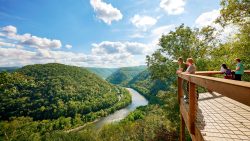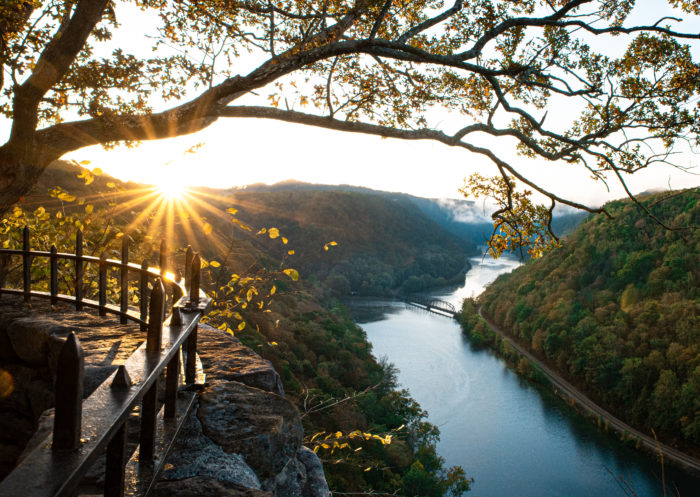17 most scenic covered bridges in the WV countryside
West Virginia’s covered bridges are some of the most photographed landmarks in the state.
Set against a backdrop of autumn color, they are perfect for leaf peeping drives. The Mountain State has 17 covered bridges, dating back to the late 19th and early 20th century– each unique in its own respect.
Here are the top 5 most historic:
1. Philippi Covered Bridge
Philippi, Barbour County
The Philippi Covered Bridge was built in 1852 to provide a link across the Tygart River on a segment of the Beverly-Fairmont Turnpike. But before it was even built, this bridge was inspiring interesting stories. Legend has it that the renowned bridge builder Lemuel Chenoweth (also known for his colorful character) won the chance to build this and other iconic bridges in West Virginia by balancing his model between 2 chairs and standing on it. That’s one way to showcase its strength!
The bridge went down in history as the site of the first land battle of the Civil War, the Battle of Philippi— a surprise Union attack on the Confederates. After a Union victory, they used the bridge as a barracks.
It’s withstood floods and fire through its time, but has been carefully restored to its Civil War brilliance. Today, it is a very notable landmark: it’s the oldest and longest covered bridge in West Virginia, and the only covered bridge serving the U.S. Federal Highway System (U.S. 250). It is also one of only a few surviving 2-lane covered bridges in the country.
2. Barrackville Covered Bridge
Barrackville, Marion County
Were it not for the bravery of a local family who loved it, this beautiful red covered bridge wouldn’t be standing. After Confederate troops swept the area, General William ‘Grumble’ Jones ordered the bridge to be burned down, destroying its infrastructure so enemy troops couldn’t use it. A nearby couple convinced him to spare it.
The Barrackville Covered Bridge spans 145 feet across Buffalo Creek, and was built in 1853 by Lemuel Chenoweth, builder of the famous Philippi Covered Bridge. The structure is a modified arched burr truss. The pedestrian-only bridge underwent a major restoration in 1998 to include a new wooden floor system, new siding and roof repairs.
3. Indian Creek Covered Bridge
Union, Monroe County
The master craftsmen who built this enduring structure were only 16 and 18 years old at the time. And their magnificent design is still one of the most photographed in the state.
Tucked along the backroads of Monroe County, where you won’t find a single stoplight or modern fast food joint, this bridge is the highlight of a pristine, pastoral landscape. Wind further through the farming community along the Rural Heritage Quilt Trail to discover more country charm among the unbridled scenery.
Indian Creek Covered Bridge is not far from Laurel Creek Bridge, north of U.S. 219. The 49.25-foot-long bridge was built in 1903 and was once part of the White and Salt Sulphur Springs Turnpike. Now owned by the county historical society, the bridge is open to pedestrians and houses antique vehicles from the 1900s.
4. Locust Creek Covered Bridge
Hillsboro, Pocahontas County
The most remote of all of the state’s covered bridges, the Locust Creek Covered Bridge’s rustic wood gives it a quaint, primitive beauty.
The bridge carried vehicles on Pocahontas County 31 after its completion in 1870. It closed to traffic after it was replaced in 1990 by an adjacent span. In 2001 the 113.75-foot-long bridge was restored to a single-lane pedestrian structure.
5. Staats Mill Covered Bridge
Ripley, Jackson County
After years of the local community petitioning for a much-needed bridge, the Staats Mill Covered Bridge was finally built across the Tug Fork of Big Mill Creek in 1888. Noted as an example of uniquely intricate timberwork, the historic 97-foot-long bridge was named for named for a water-powered mill and store owned by Enoch Staats, an early settler who played an important role in the history of Jackson County.
In 1983 the bridge was relocated across a pond at the Cedar Lakes Conference Center, where it now serves campers and pedestrians.
***
More Scenic WV Covered Bridges:
All of West Virginia’s covered Bridges are scenic reminders of yesteryear. Here are the other stunning, old-time covered bridges across the Mountain State:
6. Fish Creek Covered Bridge
Hundred, Wetzel County
The Fish Creek Covered Bridge, built circa 1881, is one of 2 remaining single kingpost truss bridges in West Virginia. The kingpost truss bridge is 36 feet long bridge and still carries traffic.
7. Carrollton Covered Bridge
Carrollton, Barbour County
The Carrollton Covered Bridge is the second-longest and third-oldest covered bridge in the state. The wooden bridge, spanning 140.75 feet across the Buckhannon River was built in 1856. Once serving as part of the Middle Fork Turnpike, the bridge carries Barbour County Road 36.
8. Center Point Covered Bridge
Center Point, Doddridge County
The 42-foot-long Center Point Covered Bridge was built in 1889. It spans Pike’s Fork (Middle Fork) of McElroy Creek just east of WV 23. The bridge no longer carries traffic, and was renovated in 2002.
9. Dents Run Covered Bridge
Laurel Point, Monongalia County
This kingpost truss construction bridge was built in 1889, spanning Dents Run. The 40-foot-long structure was restored in 1984.
10. Fletcher Creek Covered Bridge (Ten Mile Creek Covered Bridge)
Cutler, Harrison County
Built in 1891, the 62-foot-long Fletcher Covered Bridge is one of 2 covered bridges still standing in Harrison County. Stones for the abutments were quarried at the top of a hill near the bridge site. The bridge, crossing Tenmile Creek, remains in regular use today.
11. Herns Mill (Milligan Creek Covered Bridge)
Asbury, Greenbrier County
The Herns Mill Covered Bridge is one of 2 remaining covered bridges in Greenbrier County. Built in 1884, the 53.75-foot-long queenpost truss bridge carries the traffic of Greenbrier County 40 across Milligan Creek near Lewisburg.
12. Hokes Mill Covered Bridge (Second Creek Covered Bridge)
Hokes Mill, Greenbrier County
The 81.5-foot-long Hokes Mill Covered Bridge was built in 1899 carries Greenbrier County 62 over Second Creek. The restored bridge is one of 2 remaining covered bridges in Greenbrier County.
13. Laurel Creek Bridge (Lily Dale Covered Bridge)
Lillydale, Monroe County
Laurel Creek Covered Bridge was built in 1910. The shortest covered bridge in the state, it measures 34 feet long. It has wood siding painted red and a galvanized metal roof.
14. Milton Covered Bridge (Mud River Covered Bridge)
Milton, Cabell County
Also known as the Mud River Covered Bridge, the 208.5-foot-long Milton bridge was built in 1876 and served vehicular traffic on Cabell County 25 until 1985. A new bridge was built upstream in 1991 and the covered bridge was closed. The bridge underwent restoration and was moved twice, finally finding its new home over a pond at the Cabell County Fairgrounds near Blenko Glass.
15. Sarvis Fork Cover Bridge (Sandyville Covered Bridge)
Sandyville, Jackson County
Sarvis Fork Covered Bridge was built circa 1890, originally spanning John Carnahan’s Fork, a branch of Mill Creek. The 101-foot-long bridge was later moved and rebuilt over the left fork of the Sandy River and was restored in 2000. It continues to serve traffic today.
16. Simpson Creek Covered Bridge (Hollins Mill Covered Bridge)
Bridgeport, Harrison County
This 75-foot-long multiple-kingpost truss was built in 1881 and once carried the traffic of Harrison County 24/2. Washed out by a flood in 1899, the structure was relocated to its present setting in a park near Highways’ District Four headquarters, where it now serves pedestrians.
17. Walkersville Covered Bridge
Walkersville, Lewis County
Built in 1903, the 39.25-foot-long Walkersville Covered Bridge transports vehicles on Lewis County 19/17 over the Right Fork of West Fork River. The Queen post truss bridge has board-and-batten siding and a standing seam metal roof. The bridge underwent restorations in 2004.
Which of these landmarks have you visited?
This post was last updated on July 21, 2020








